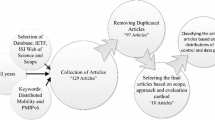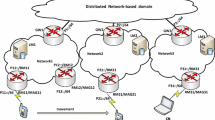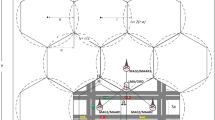Abstract
Current network mobility management protocols allow users to access broadband Internet while moving in vehicles or from vehicles to fixed locations without breaking ongoing sessions. These protocols rely on a central mobility anchor such as home agent or local mobility anchor. Thus, some issues, including a single point of failure, long handover delay, and scalability, are exposed in these existing approaches. Ever-increasing demand for mobile Internet traffic changes the mobile network from a hierarchical architecture to a flat architecture and distributed schemes are being researched for the purpose of adapting to new flat architecture and overcoming the aforementioned issues. In this paper, we do a survey of existing network mobility management protocols, current solutions for distributed mobility management, and present an efficient PMIPv6-based distributed network mobility management scheme. The proposed scheme consists of characteristics of distributed mobility management and a new handover mechanism to reduce the packet delivery overhead while keeping seamless Internet access to users in vehicles. By numerical analysis, we prove that our new approach improves service disruption time and packet delivery cost compared to exiting solutions under various environment conditions.










Similar content being viewed by others
References
Devarapalli, V., Wakikawa, R., Petrescu, A., & Thubert, P. (2005). Network Mobility(NEMO) basic support protocol. IETF RFC 3963.
Gundavelli, S., Leung, K., Devaraplli, V., Wichorus, Chowdhury, K., & Patil, B. (2008). Proxy Mobile IPv6. IETF RFC 5213.
Park, S. (2008). Relay based network mobility support in proxy mobile Ipv6 networks. In Proceedings of IEEE CCNC (pp. 227–228).
Soto, I., Bernardos, C. J., Calderon, M., & Banchs, A. (2009). NEMO-enabled localized mobility support for internet access in automotive scenarios. IEEE Communications Magazine, 47(5), 152–159.
Jeon, S., & Kim, Y. (2011). Cost-efficient network mobility scheme over proxy mobile IPv6 network. IET Communications, 5(18), 2656–2661.
Chan, H. (2014). Requirements of distributed mobility management. IETF RFC 7333.
http://datatracker.ietf.org/wg/dmm/. Accessed August, 2014.
Anthony Chan, H., Yokota, H., Xie, J., Seite, P., & Liu, D. (2011). Distributed and dynamic mobility management in mobile Internet: Current approaches sand issues. Journal of Communications, 6(1), 4–15.
Shin, D.-H., Moses, D., Venkatachalam, M., & Bagchi, S. (2013). Distributed mobility management for efficient video delivery over all-IP mobile networks: Competing approaches. Network, IEEE, 27(2), 28–33.
Seite, P., & Bertin,P. (2014). Distributed mobility anchoring. IETF draft.
Bernardos, C.J., & Zuniga, J.C. (2014). PMIPv6-based distributed anchoring. IETF draft.
Do, T.-X., & Kim Y. (2012). Distributed network mobility management. In International conference on advanced technology for communication (ATC 2012) (pp. 319–322).
Arora, I., & Gupta, A. (2012). Cloud Databases: A Paradigm Shift in Databases. International Journal of Computer Science Issues, 9(4), 77–83.
Aboba, B., Beadles, M., Arkko, J., & Eronen, P. (2005). The network access identifier. IETF RFC 4282.
Chan, H. (2010). Proxy Mobile IP with distributed mobility anchors. In GLOBECOM workshop on seamless wireless mobility.
Thomson, S., & Narten, T. (1998). IPv6 stateless address autoconfiguration. IETF RFC 2462.
Makaya, C., & Pierre, S. (2008). An analytical framework for performance evaluation of IPv6based mobility management protocols. IEEE Transaction on Wireless Communication, 7(3), 972–983.
Jeon, S., Kang, N., & Kim, Y. (2008). Enhanced PMIPv6 route optimization handover. IEICE Transaction on Communication, E91-B(11), 3715–3718.
Figueiredo, S., Jeon, S., & Aguiar, R. L. (2012). Use-cases analysis for multicast listener support innetwork-based distributed mobility management. In IEEE 23rd international symposium on PIMRC (pp. 1478–1483).
Bertin, P., Bonjour, S., & Boonin, J. (2009). Distributed or centralized mobility. In Global telecommunications conference (pp. 1–6).
Giust, F., Oliva, A., & Bernados, C.J. (2011). Flat access and mobility architecture: An IPv6 distributed client mobility management solution. In Computer communication workshops (INFOCOM WKSHPS) (pp. 361–366).
Yim, T., Nguyen, T.M., Hong, K., Kyung, Y., & Park, J. (2014). Mobile flow-aware networks for mobility and QoS support in the IP-based wireless networks. Wireless Networks, 20(6), 1639–1652.
Acknowledgments
This work was partly supported by the ICT R&D Program of MSIP/IITP [No. 2014-044-011-002, Distributed & OpenFlow Based Virtual Mobile Core Network] and the ICT R&D program of MSIP/IITP [No. I2221-14-1001, Next Generation Network Computing Platform Testbed].
Author information
Authors and Affiliations
Corresponding author
Rights and permissions
About this article
Cite this article
Do, TX., Kim, Y. EPD-NEMO: efficient PMIPv6-based distributed network mobility management. Wireless Netw 21, 2303–2314 (2015). https://doi.org/10.1007/s11276-015-0916-1
Published:
Issue Date:
DOI: https://doi.org/10.1007/s11276-015-0916-1




